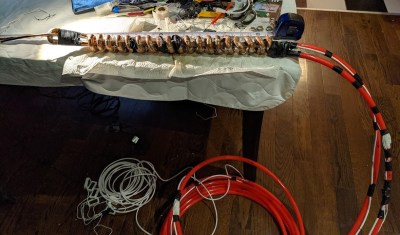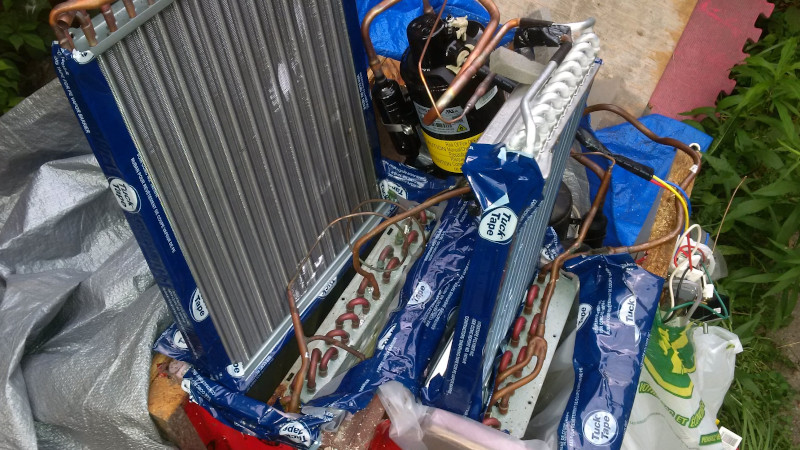When it comes to lower-energy home heating, it’s accurate in all senses to say that heat pumps are the new hotness. But unless you happen to work with them professionally, it’s fair to say their inner workings are beyond most of us. Help is at hand though courtesy of [petey53], who made his own ground source heat pump for his Toronto house using a pair of window-mounted air conditioning units.

An aircon unit is a heat pump that’s designed to scavenge heat from the air indoors and dump it into the warmer air outside. Thus it’s ideally suited to the task of doing the opposite, but the clever part lies in how he uses it as a ground source pump rather than an air source.
He carefully bent the tubing of the aircon to allow hot and cold radiators to sit in water baths, with the hot side feeding an underfloor heating loop and the cold side is a long length of pipe buried in the garden. Meanwhile, a Raspberry Pi paired with a repurposed Droid Alpha robot controller runs the pumps.
It’s exciting to see a relatively simple route into having a heat pump, and we’d hope to see more coming our way over time. We’ve seen geothermal PC cooling. Far more common, so far, have been heat pump controllers.
















That’s a hack alright.
‘Hack’ is a funny word, it can be good or bad, depending on context.
His cold side will freeze up. Water not a good choice. Also unlikely he buried ‘ground loop’ far enough underground (Toronto so 3 feet or so). Why would he? Obviously not intended to be permanent.
Not bad, for a Canadian. Needs more duct tape. The high grade kind.
From TFA:
“pumps a water/glycerin mix”
and
“First I made a 9 ft deep hole”
Still, why bother reading something when you have comments to post?
I think this is a great experiment and the fact that it’s been going all winter makes this one high quality hack.
Not bad for a Canadian eh? You better watch yourself when you are in Canada, we might not hold the door open for you, ya hoser.
Except all the refrigerant leaks/ lost refrigerant from the original systems doing more to ruin the earth than anything else available.
Apparently you didn’t read that the original refrigerant system is still intact.
R290 and R600a to the rescue. Been using that since before it was cool. (Oh yes I just did that)
It works great. Back in the day people would F up their R22 air conditioners and leave them on the curb dead, I’d solder the holes shut and fill them back up with “hamburger gas” and run them for the season. The only reason we’d replace them was that we would find a bigger unit.
Obviously we’d properly vacuum them out and do everything to keep things safe, but performance and power usage was on par and they never died from anything attributable to the change in refrigerant. Imagine how good things are now that it’s legal and commonplace, what, with all the properly formulated oils, orifices and compressors.
Do some reading on the lobbying that went on when CFCs came out. It’s disgusting and completely unsurprising.
What is “hamburger gas”? Propane? LPG?
Thought about this -Isn’t hamburger gas propane ? Yes it can ne used as a refringent but fundamental problem is that it is flammable and or explosive –
never thought hack is a bad word ….
Yes hack like the name hacksaw suggests is ripping onto something without regard for damage. To hack at something is to cause it damage..right?? So yes a hack is much more likely to be a derogatory phrase than a complimentary one… Though it’s been used to describe a smart or novel way if doing something.
And air source heat pump where the air goes through a long and deep “earth tube” is another option. Less tech to fail and servicing the unit is just the same as normal, it is just that it is working against preconditioned air that is closer to the annual average temperature in the region. All it takes is a sheet metal faring to direct the air from the tunnel to the inlet side of the coils of the external unit.
Brilliant idea! What about sewers? A lot of heat going to waste in them. Might need an air to air heat exchanger in case gas or stink is a problem!
You cant use the sewer. The fat will freeze solid and clog the sewer.
Storm drains on the other hand seem like a good idea; the big cistern catchments which get leaves and other organic matter frequently start to compost themselves, with that biological activity generating enough heat that some of them will appear to ‘steam’ on a cold day.
And no risk of fatbergs.
Could you please all leave a diagram of tubing and other parts necessary. So we can start working on it to see if the system can heat up at least one room! And then work on for rest of the bed room and open area.
https://nationalwesterncenter.com/about/what-is-the-nwc/sustainability-regen/energy/
You can also use sewers for a water to air loop that should protect you from the nasties. Introduce a long hose loop into the pipe. Keeping in mind the risk of blocking it, but in a pinch if you need to ghetto it sure why not?
If you occasionally need to have a bonfire, have it on the coldest days of the year, feeding the smoke into your ASHP.
Smart idea.I’ve thought of your “earth tube” for preconditioning ventilation air, but then there are concerns of legionella if your tunnel holds any water. Your idea improves the COP of the heatpump and eliminates the potential for legionella in your indoor airstream. Still not sure I have a practical way to pull this off in my yard, but its fun to dream.
It starts with a big long hole, and or tapping into existing pipes in the area, such as storm water drains.
The difference is expense and efficiency. Water is basically incompressible fluid that carries heat well. Air is neither, so underground air tubes have to be large and sturdy to avoid collapse and carry heat. Water pipes can be run thru common Pex piping at pennies a foot vs air would run thru 4″ corrugated drain pipe at $$$/foot. Look up geothermal greenhouses who try it and the ground loops are tens of thousands.
I love this project. I’ve been perplexed recently for why we don’t have dual air/geothermal heat pumps to allow us to use air source heat pumps with some ground supplementation to overcome the limitations of both. Most of the time air is a fine source, but in some areas and certain times of the year there is t enough heat on the air for the less efficient heat pumps. But making a coil big enough for pure geothermal is hard in many areas. So why not have a smaller buried coil to supplement the air? I’ve been kicking around ideas and trying to figure out how to modify an air source to use the ground as a supplement so this is a useful proof of concept
A ten foot round by four high compost pile with a one hundred coil of polyethylene pipe three quarter diameter filled with anti freeze fluid could help these hacks work. Small pump would be placed in line.
but it would freeze so fast then the bacteria would stop doing their thing!
Only those people can do this one who leaves in a big firmland. Ten foot diameter is a big land and this may produce smell also. So no neighbors should be around. If understand the theory correctly.
The new “net zero” heat pumps are supposed to efficiently pull more heat from colder air (like down to 5 degrees F if I remember the “marketing” correctly). This is supposed to eliminate the issue and cost of geothermal units. Do they work as advertised? Time will tell..
My existing (not new) air-source heatpump (Mitsubishi Hyperheat) is good to -13F. Not saying it operates _efficiently_ at -13F, but per the submittal documentation, it does function.
I just installed a Fujitsu heat pump for a client, it operates at full capacity to -15f with an HSPF of 12 (I think, I get the numbers mixed up now with the updated rating system coming out)
Te fastest geothermal technology to implement is moving to your basement…..
I am looking into the same idea. Basically a small loop in the backyard, filled with glycol and a heat exchanger on the air source heat pump. Can be used in conjunction with a solar water heater with evacuated tubes to boost the heat in sunny days.
I do not really have the space for it but I’ve been thinking of putting the airco outside unit in the attic with ducting to the outside for the summer and to the inside for the winter.
In summer I wil flip to the ducting outside and get cool air in and out.
In the winter time I use the warm air from my house that rises up so the outside unit will not freeze up.
I now this warm air is partly made by the same airco so the return would not be as efficient as you expect but in normal condition the unit is outside and the warm air will just vanish so there is really nothing to lose.
I do not really use the attic for something else than storage so it would be possible.
Spent uranium fuel bundles from reactors?? Wrapped in lead and then wrapped in aluminum? use for air source?
[Jenny List] nice writeup! I think it’s a really cool project.
I think it’s a really warm project 😎 Sorry, not native in english…
That word was used in the first Reddit comment!
I have a lukewarm reaction to this project.
They used glycerin/water mix, which depending on the ratio and the temperature it shouldn’t freeze. Also safe enough in spill in the ground should it leak, a good enough choice I guess.
If engine antifreeze was considered, propylene glycol would be preferred over ethylene glycol. Propylene glycol is the “marine” version I think, due to the much lower toxicity.
PG is commonly available as RV antifreeze. In smaller quantities it’s available in fat-free salad dressing. It’s still not great for the marine environment, but less bad than EG.
I love the IDEA of geothermal.
Unfortunately, geothermal’s amazing ROI calculations are always done with a large home and compared to low SEER heat pumps or just electric baseboards and old inefficient AC unit.
If you’re truly comparing geothermal to equivalently priced options (a high SEER air/air heat pump) then geothermal’s ROI sucks.
Pipe and labor are the problem, similar issue with solar. Professional advertisers on Youtube love talking about it because they either got part/all of it paid for, or installed the pipe themselves as a business write-off.
If you’re wealthy, geothermal is a great option.
It depends a lot local conditions. However, direct-exchange geothermal has promise on reducing cost and increasing efficiency… especially if they can switch to a lower GWP refrigerant.